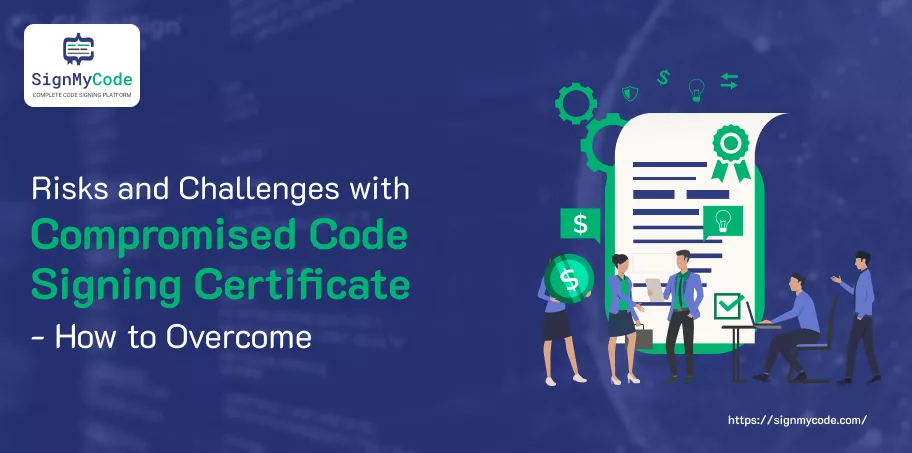Risks and Challenges with Compromised Code Signing Certificate – How to Overcome

Do you know almost 88% of companies experience unplanned outages due to expired certificates? Given these big numbers, ensuring the safety and reliability of software with code-signing certificates is vital.
However, when a code signing certificate is compromised, it can pose significant risks that can undermine the trustworthiness of software distributed to users.
In this blog, we are going to discuss all those risks and challenges, along with some tips on how to overcome them. Let’s begin!
What Is a Code Signing Certificate?
Code signing is a cryptographic method used to prove that the software is authentic and genuine. By digitally signing software, apps, or embedded firmware with a code signing certificate, end-users are ensured that the software comes from a trustworthy source and has not been altered since its publication.
Here’s Why Code Singing Matters!
- Ensures the integrity of software by confirming that it has not been tampered with.
- Reduces the risk of downloading malware or malicious software.
- Protect software from being modified by unauthorized parties.
- Many industries and organizations require code signing as part of their security policies and compliance regulations.
- Builds trust between a brand and its consumers.
Risks & Challenges With Compromised Code Signing Certificate
Phishing Attacks
In phishing attacks, cybercriminals behave as trusted entities to trick individuals into sharing their personal and sensitive information.
Now, compromised code signing certificates enable sophisticated phishing attacks. How? It provides a false sense of trust to unsuspecting users.
Attackers use these certificates to sign phishing emails or fake websites, making them appear legitimate and trustworthy.
Reputation Damage
The risk of a compromised code signing certificate goes beyond security breaches and hampers the organization’s reputation. Here’s how!
People trust signed software because they think it’s safe. But if they find out that signed software actually has malware, they lose trust in the brand that owns the certificate.
Recommended: Software Developers FAQs on Why to Sign My Code
Discovering that malware was spread using a compromised certificate can make people think the owner is not careful or secure. This damages relationships with customers and partners.
Auditing & Compliance Issues
Compromised code signing certificates lead to compliance violations with industry regulations and security standards. For instance, certain sectors such as healthcare, finance, or government have strict requirements for software security and integrity.
These also complicate auditing processes. How? To verify the authenticity and security of software used within an organization, auditors rely on code signing. If the certificates are compromised, auditors may question the potency of the security controls and procedures in place.
How To Overcome Code Signing Risks?
Follow the effective methods to overcome and avoid code signing risks!
Safeguard Private Keys
Private keys that are used by developers to sign code are indispensable to cybercriminals.
How?
If hackers get hold of these keys, they can sign malicious code and distribute it to many users without detection.
Recommended: Top Best Practices for Storing X.509 Private Keys
Developers often store these keys in insecure places, such as their own computers or servers. This makes it difficult for IT teams to keep track of them and protect them properly.
To stay safe, businesses should follow the below measures.
- 71% of organizations don’t know how many digital certificates and keys they exactly have. So, take stock of all code signing keys to understand their scope and location.
- Use centralized management systems to handle these keys more securely.
- Store private keys in certified hardware security modules (HSMs).
- Consider using flexible cloud-based solutions for security that can scale as needed without the hassle of maintaining physical hardware.
Time-Stamp Code
When code is signed with a timestamp, it records the exact time it was signed. So, by applying a time stamp to the code, you can ensure that the certificate remains valid even after its validity for signing expires. This is especially useful for long-term validity and compliance.
What if the malware is detected and the associate certificate is revoked? Here, timestamping will ensure that the revocation effect will only affect software released after the date of the security compromise.
Secure Development Practices
Many times, developers take shortcuts on security to release the software faster. But these results in several vulnerabilities which can’t be ignored.
To overcome these, switch from the traditional software development life cycle (SDLC) process to the more modern secure SDLC.
Below is an example of a secure software development life cycle (SDLC) process.
During the development process, developers must use self-signed certificates, which they should replace with publicly trusted certificates when moving to production.
Note: Never use self-signed certificates in production because they are not secure enough.
Use an Automated PKI Life Cycle Management Solution
Managing and securing every single step of the software supply chain manually is not practically possible as it’s risky and too complex. Instead of doing this, follow the below tips.
- Use a certificate management tool.
- Implement public key infrastructure as a service (PKIaaS) to automate and simplify PKI management responsibilities.
- From issuance to deployment and renewal, automate the whole certificate life cycle.
Don’t Overuse One Private Key for Signing
The private key loss will result in certificate revocation, unfortunately invalidating the signatures. So, always take a diversified approach and avoid signing all the codes with one single key and certificate. This helps minimize the impact of key loss and ensures continuity in software integrity.
Secure Signing Operations
If a hacker breaches the developer network, they don’t need to steal any other private key to submit malware. This is known as “software supply chain attacks,” which we have already explained above.
How to Overcome These Situations? Read on to find out!
- Ensure that only authorized users are gaining access to sign and approve the code at the right time.
- Track every single use of private keys to sign the code.
- The certificates used in production signing must be different from the development and testing stages.
- Make different entities between individuals responsible for submitting code for signing and those who approve signing requests. This separation improves security and accountability by ensuring that no one person has complete control over the entire signing process.
Revoke Compromised Certificates
Whenever certificates are compromised, inform your certificate authority (CA) as soon as possible. They will help you with the revocation process, which will render the software invalid and prevent the further propagation of malware.
Important: When the private keys of the certificate start showing signs of being compromised, revoke it immediately.
Continuously Monitor & Audit
Over time, algorithms weaken, threats evolve, and as a result, the certificate expires. That’s why ensuring the security of code signing certificates is a continuous process, not a set-and-forget deployment.
- Monitor your code signing activities in real time to detect anomalous activities effectively.
- Maintain a comprehensive log & audit key usage. Keep an eye on who, when, and how used the code signing keys.
- Ensure that all the digital certificates are authorized by certificate lifecycle management (CLM), including Extended Validation and Standard Code Signing Certificates.
| OV Code Signing | Starts at $199.99/yr |
| EV Code Signing | Starts at $269.99/yr |
Conclusion
Security measures are taken for granted until the threat has become prevalent. As we all know, cyber threats are continuously evolving. To mitigate the risks of compromised code signing, organizations must follow the above practices and protect their applications with confidence.
Simplify Code Signing With SignMyCode
SignMyCode is a complete code signing platform solely focused on providing the best code signing solutions from multiple and trusted certificate authorities. Price Starts at Just $199.99 Per Year!
Why Choose Us?
- Globally known & trusted certificate authorities from different brands, including Sectigo (Formerly known as Comodo), DigiCert, and Certera.
- Affordable pricing
- User-friendly interface
- 24/7 instant support
- Money-back guarantee
- One-click automatic tool
To learn more about our platform, head to our products section or get in touch with our experts if you have any queries.

